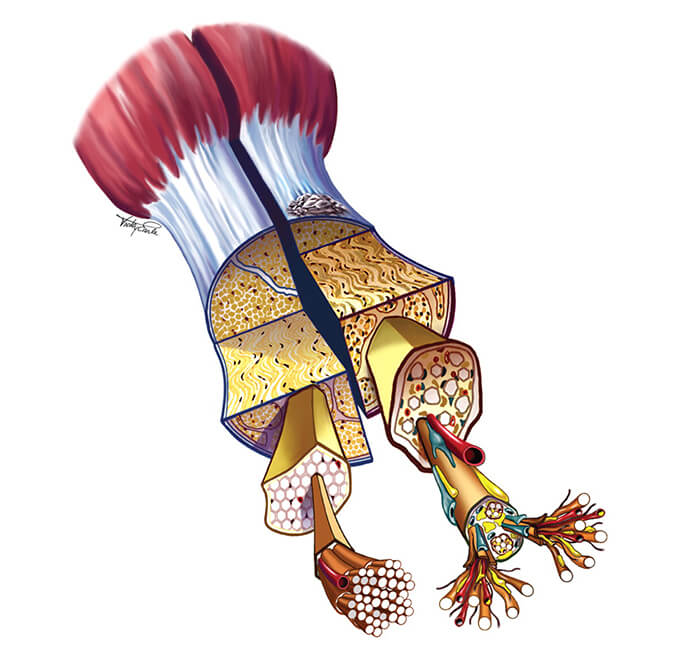Tendons are the connective tissue between muscle and bone. They are primarily made up of tight bands of collagen fibres which gives them strength to withstand high loads. Tendons are surrounded by a sheath called synovium and have a relatively weak blood supply in comparison to muscles.
Tendinopathy (tendon injury) is an acute or chronic disorder of the tendon. The word tendinopathy is an umbrella term that encompasses “tendinitis”, “tenosynovitis”, “tendinosis” and “partial or full thickness tears”. Ultimately, they are all tendon injury pathologies.
Research has led to tendinopathies being categorised into 3 stages, called the ‘tendon continuum’.
- Reactive tendinopathy – no inflammation in the tendon, minor collagen fibre separation, some swelling and thickening of the tendon visible through imaging, tendon is able to return to its normal state through reduced load.
- Tendon Disrepair – increased separation and disorganisation of collagen fibres, visible changes on MRI and US, evidence of new tiny blood vessels and nerves within the tendon, caused by overloading a tendon that is already in phase 1 – Reactive tendinopathy.
- Degenerative tendinopathy – cell death and disorganisation of the tendon cell matrix, tendon is thickened with nodular sections on palpation, changes are now irreversible.

Treatment for tendinopathies?
One word: LOAD! A graded strength training approach designed to improve function (i.e. neuromuscular movement patterns of the entire body under load) will result in decreased tendon pain. This rehab protocol is very individualised, however it should include a gradual progression of isometric, kinetic chain, functional, endurance, eccentric and plyometric strength exercises. You will always have tendon pain unless you improve function.
Exercise prescription is complex and there are many variables to consider. The finer details include: How many sets and reps? How much rest? When do we progress? Exercise prescription is dynamic and needs to be considered on a day to day, week to week basis.
Overall tendon heal time can be anywhere from 3 to 6 months. Progress is slow! Do not expect a quick fix AND do not expect passive treatment (i.e. massage, taping, electrotherapy, dry needling, ice, medications, injections) to fix your condition.
Complete rest? …bad idea! The tendon tissue loses structure, musculotendinous strength reduces (negative changes can be seen in just 2 weeks), kinetic chain function deteriorates, and neural drive/motor control diminishes. The strength of any tissue will only be as great as the load placed on it. Therefore, decreased load = decreased tissue capacity AND increased potential for more injury.

One final take home message: tendon pathology causes the tendon to adapt and develop much more tissue that can take load. In fact, research has shown that pathological tendons have MORE good structure than a normal tendon. This means that we can load these tendons because we still have plenty of good tissue. The analogy used here is a donut – the hole (injured area of tendon) is useless to us, we don’t need it. We still have plenty of donut (healthy remaining tendon) that we can load. So, do not avoid strength training because of fear that “I might get worse”. Instead, modify the exercises and modify the load. If you gradually progress the load, and gradually progress the difficulty of function, you will decrease your pain and improve your strength/performance!


